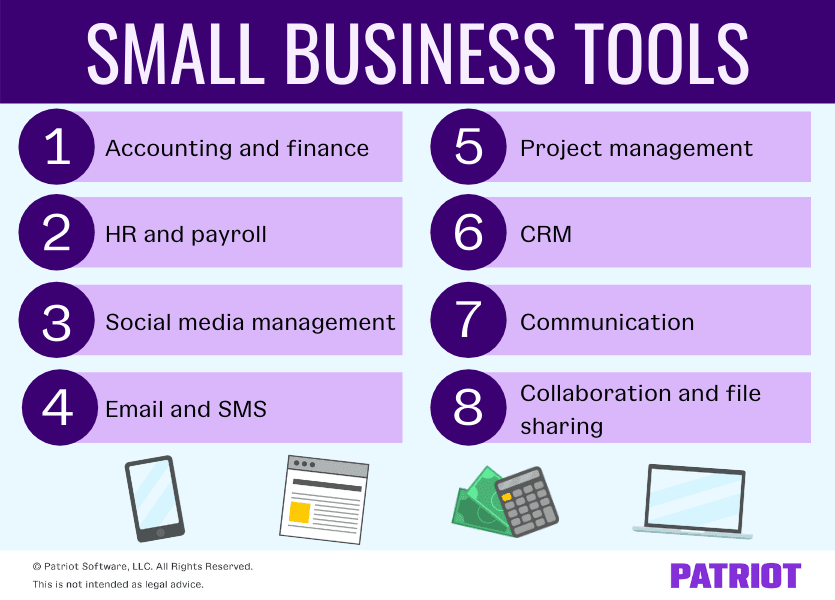Small businesses are the lifeblood of any economy. Over 90% of the business population represents the small to medium enterprise (SME) population. Yet while SMEs make up a large portion of business owner shares, GDP, and economic activity, most of them struggle.
As the COVID-19 pandemic hit, most small business owners experienced the severe economic effects of lockdown. One of the most significant pain points in this new reality is learning how to streamline your business to stay efficient and keep growing.
Fortunately, we now live in the digital age—a time where the internet comes in an abundance of affordable or even free tools that can help small business owners save time, resources, and energy.
While there are job automation risks to consider, it’s undeniable that this technology brings many benefits as long as it’s implemented with best practices. Leveraging these tools will radically change the way you operate your business and help you thrive amidst these trying times.
8 Tools to streamline your business
Here are eight small business tools that owners can use to streamline their operations.

1. Accounting and finance tools
One of the most basic business operations tools you must have is an accounting and finance tool. Transferring to a digital accounting system helps small businesses save on printing and file storage costs, which adds up in time. And, many business owners save time and energy manually going through piles of receipts, invoices, and other accounting documents annually.
Accounting software is one of the common business systems available online.
2. HR and payroll tools
Human resource and payroll duties are vital to any company that employs staff. But not all small businesses can afford an HR department.
Business owners can now access various tools online that can help with various human resource tasks, including recruitment, onboarding, payroll tax computing, salary disbursement, people management, and many others.
There are also dozens of online tools that help with time tracking and online attendance monitoring. This helps companies virtually keep tabs on their staff’s productivity and performance, even if your team works from home.
3. Social media management tools
Another non-negotiable business activity for small businesses is marketing and sales. Most SMEs don’t have the multi-million budgets and large marketing departments that larger corporations have at their disposal. However, they can leverage other highly-effective marketing and sales strategies, such as:
- Word of mouth marketing
- Online advertising
- Social media marketing
Manually managing a social media page can take up a lot of time. But, there are many tools and resources to help with social media management activities. These tools can help with post scheduling, responding to comments and messages, graphic design, and other social media tasks.
Small business owners can also tap into chatbot marketing by creating autoresponders that automatically respond to queries, saving countless hours of manually responding to messages and comments.
4. Email and SMS tools
The two main channels that businesses communicate with customers and clients today are email and text. Business owners spend hours per week sifting through and sending emails and text messages.
Now, there are tools that can streamline and automate these processes. Email and SMS tools for small businesses can automate tasks like:
- Sending appointment reminders
- Sending payment alerts
- Announcing discounts and offers
- Sharing business news
- Scheduling meetings
- Providing customer support
Automating email and SMS send-outs helps save time and increase accuracy by removing the arduous human error factor.
5. Project management tools
When streamlining operations, businesses must stay on top of the day-to-day tasks and activities that their team jumps into. This aspect of business operations is one of the very few advantages that a small organization has over larger corporations. Managing smaller and more agile teams makes for better project management.
But, that’s not to say that business owners and their teams should become lax about project management. Give your project management an extra boost by deploying the right tools for project management.
There are many task management tools out there (e.g., Monday, Trello, Asana). Each offers various features and benefits, and most come with a free plan. That way, you can make the most of the basic features at little to no cost.
6. CRM tools
When a business builds momentum and starts getting leads, the real work begins. Many small companies drop the ball throughout the sales funnel process by losing potential customers through the buying journey. Sometimes, sales representatives fail to follow up in a timely manner or lose the contact details of a certain prospect.
To avoid these fatal business errors, maintain a form of client relationship management. CRM tools (e.g., Salesforce, Hubspot, Infusionsoft) can help capture, qualify, and categorize leads.
Many CRM tools integrate seamlessly with websites to collect inquiries and prospect information through contact forms and chat support. A business can also connect CRM tools with their emails to send follow-up messages to clients and prospects.
7. Communication tools
For businesses trying to learn how to improve the operation and management of business tools, communication might be a choke point. Many companies make the mistake of using too many business communication tools or using the wrong one.
Some communication tools are great for internal communications (e.g., Slack) but not for talking to an external partner or potential client.
Whichever tool you use to communicate with your team (e.g., Slack), make sure it’s clear and central. Avoid using other channels to communicate when you decide on certain tools to prevent confusion.
8. Collaboration and file sharing tools
In today’s digital age, most documents and files shared amongst teams come in a digital format. When sending reports, word documents, graphics, or small video files, companies need a file-sharing tool to share multiple documents and files at once seamlessly.
File-sharing tools (e.g., Google Drive, Dropbox, OneDrive) allow employees to upload files online and share them easily with teammates, customers, and clients.
These views are made solely by the author.



